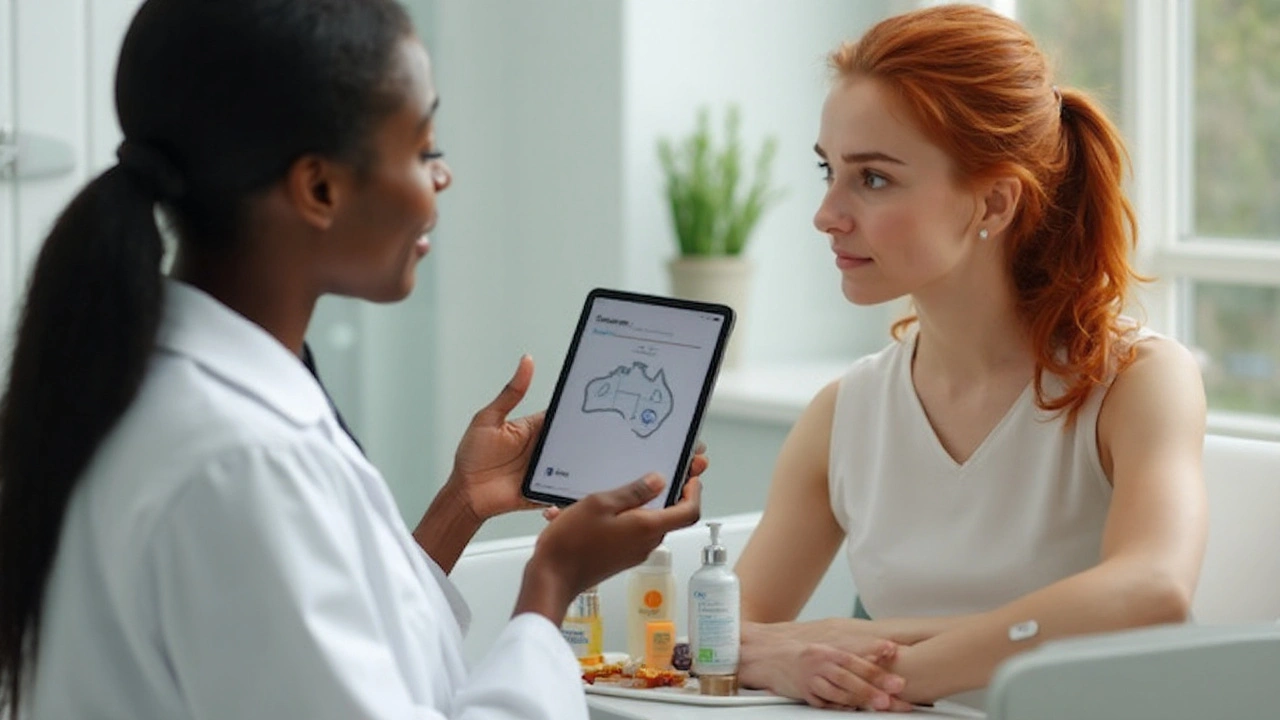
If you’re googling Eukroma Cream, you’re likely wrestling with melasma or stubborn dark spots and want something that actually works. Eukroma is a hydroquinone 4% cream-potent, proven, and not a casual moisturiser. It can fade hyperpigmentation, but it needs careful use, a prescription in Australia, and strict sun protection. Expect steady progress, not miracles, over 4-12 weeks. And if you’re pregnant, breastfeeding, or sun-heavy (hello, Sydney), this may not be your first move.
What Eukroma Cream is, what it does, and what it doesn’t
Eukroma is a brand of hydroquinone 4% topical cream used to lighten areas of excess pigment. It’s typically prescribed for melasma, post-inflammatory hyperpigmentation (PIH) from acne or eczema, and sun spots (solar lentigines). Hydroquinone reduces melanin production by inhibiting tyrosinase-think of it as turning down the pigment tap while you fix what triggered the overproduction.
What you can reasonably expect:
- Visible improvement in 4-8 weeks with consistent use and daily SPF50+.
- Best results in 8-12 weeks, often followed by a rest period or switch to maintenance actives.
- Uneven fade is normal at first. It evens out if you’re patient and consistent.
What it won’t do:
- Work without sunscreen. UV and visible light trigger melasma and PIH. No SPF, no progress.
- Erase freckles or intrinsic skin tone. It targets abnormal pigment, not your natural colour.
- Stay safe if you push it for months on end. Overuse ups your risk of rebound darkening and rare ochronosis (bluish-grey discoloration).
Who it’s for:
- Adults with diagnosed melasma or PIH who can commit to daily sun protection and gentle routines.
- People who’ve tried azelaic acid, vitamin C, or cysteamine and still need a stronger, supervised option.
Who should avoid it (or get specialist clearance first):
- Pregnant or breastfeeding women.
- Anyone with active eczema, broken skin, or known allergy to hydroquinone.
- People unable to use sunscreen daily (outdoor jobs without protection, tanning habits).
“Hydroquinone is the most commonly used depigmenting agent worldwide.” - DermNet NZ
In Australia, hydroquinone above 2% is prescription-only (Schedule 4 under the Poisons Standard). A 4% cream like Eukroma is not legally sold over the counter. Your GP or dermatologist can prescribe it where appropriate, and a community pharmacy can dispense a registered brand or a compounded equivalent if needed.
How it fits into a routine (a sensible template your prescriber may tweak):
- Night: Cleanser → thin layer of hydroquinone on dark patches → bland moisturiser as needed.
- Day: Antioxidant or azelaic acid (if approved) → moisturiser → broad-spectrum SPF50+ → reapply every 2 hours outdoors.
- Avoid benzoyl peroxide on the same areas (it can oxidise hydroquinone and cause temporary dark staining of the cream on skin or fabrics).
How long to use: Many dermatologists prefer limited courses (for example, up to 8-12 weeks), then a break or transition to maintenance actives like azelaic acid, kojic acid, niacinamide, or cysteamine. If you see no improvement by 8 weeks, book a review-your diagnosis or triggers might need rethinking.
Evidence snapshot: Hydroquinone 4% has decades of clinical use behind it. In melasma, it’s a core ingredient in the classic “triple combination” therapy (hydroquinone + tretinoin + a mild steroid), which often outperforms single agents for moderate to severe cases. Australian availability of fixed triple combos is limited, but compounding is an option-your dermatologist will guide you.
| Parameter | Details (Australia, 2025) |
|---|---|
| Active ingredient | Hydroquinone 4% w/w |
| Indications | Melasma, post-inflammatory hyperpigmentation, solar lentigines |
| Legal status | Prescription-only (Schedule 4) when >2% |
| Typical regimen | Thin layer nightly to affected areas for 8-12 weeks (or as directed) |
| Time to results | 4-8 weeks to see change; best at ~12 weeks |
| Must-have | Daily broad-spectrum SPF50+; avoid peak sun, heat, and visible light exposure when possible |
| Common side effects | Dryness, mild burning, redness, peeling |
| Serious but rare | Exogenous ochronosis (bluish-grey discoloration with prolonged/unsupervised use) |
| Not for | Pregnancy, breastfeeding, broken skin, known allergy |
| Interactions/cautions | Use caution with retinoids, AHA/BHA; avoid benzoyl peroxide on same area |
| Storage | Tightly closed, away from heat/light; follow label |

How to get it in Australia (2025): legit, legal, and safe
Because hydroquinone 4% is prescription-only here, the right path is simple and safe. Buying from overseas websites can land you with counterfeit or degraded products, and it may be illegal to import depending on quantity and declaration. Here’s the clean, fast route.
- Confirm it’s the right tool. If your dark patches deepen with heat/sun and have a map-like pattern on cheeks/forehead/upper lip, you might be dealing with melasma. For acne marks (PIH), hydroquinone can help too, but azelaic acid is often tried first. Either way, get a diagnosis from a GP or dermatologist.
- Book your appointment. Ask specifically about hydroquinone 4% and alternatives. Flag any key details-pregnancy plans, sensitive skin, previous reactions, outdoor job.
- Discuss a plan. Expect talk about SPF, triggers (heat, hormones), and duration. If you’re a good candidate, your doctor may prescribe hydroquinone 4% as a standalone or in a compounded triple mix. If not, they’ll suggest options like azelaic acid 15-20%, cysteamine 5%, or tranexamic acid (topical or off-label oral).
- Fill your prescription at a community pharmacy. They’ll dispense a registered brand or arrange compounding if a custom formula is prescribed. Ask about storage and how long the cream remains stable once opened.
- Set expectations before you start. Take a clear, makeup-free photo in good light. Mark your start date. Plan daily SPF50+ and reapplication basics (hat, shade, set phone reminders).
How to spot genuine stock and quality handling:
- Packaging should have a batch number and expiry date. The cream should be uniform in colour (off-white) with no odd smell. If it’s darkened or grainy, return it.
- Ask your pharmacist about the manufacturer, storage conditions, and beyond-use date for compounded creams.
- Request the Consumer Medicine Information (CMI) or printed usage directions. Keep it.
Finding official info without guesswork:
- Search “TGA hydroquinone Poisons Standard” to verify scheduling (Schedule 4 for >2%).
- Search “ARTG hydroquinone cream” to locate Australian-registered entries and check product details.
- For clinical guidance, look up DermNet NZ (hyperpigmentation, melasma) or Australian dermatology society resources. These outline realistic timelines and safety notes.
What it costs (ballparks vary):
- Prescription consult: Standard GP gap fees vary widely by clinic.
- Hydroquinone 4% tube (registered or compounded): Commonly a private script; pricing differs by pharmacy and formulation. Ask for a quote before compounding.
When to pause and call your prescriber:
- Intense burning, swelling, blistering, or persistent redness beyond the first 7-10 days.
- Dark, slate-grey patches appearing in treated areas (flag for possible ochronosis).
- No improvement by week 8-10 despite perfect sunscreen use-time to switch or escalate care.
Reporting problems: You or your clinician can report adverse events to the TGA. Keep the tube, batch number, and photos. Your feedback helps maintain safety standards.

Side effects, precautions, and smarter alternatives
Common side effects are mild and manageable-think dryness, tingling, a touch of redness. Ease in by applying every other night for the first week, then nightly if your skin tolerates it. Use a gentle, fragrance-free cleanser and a simple moisturiser. Avoid new acids or scrubs while you’re getting started.
Patch test protocol:
- Apply a pea-sized amount to a small test area on the jawline for 3 nights.
- Skip if you get severe stinging, intense redness, or hives-contact your prescriber.
- If it’s fine, proceed to affected areas only (not full-face unless instructed).
Big risks to know:
- Exogenous ochronosis (rare). More likely with long-term, unsupervised use, higher concentrations, or under occlusion. Shows as slate-grey patches that don’t fade quickly.
- Rebound pigmentation. Happens if you stop suddenly then get lots of sun/heat exposure. Plan maintenance and sunscreen.
- Contact dermatitis. If you get a rash, stop and get reviewed-sometimes a switch to azelaic acid or a compounded lower strength helps.
Smart rules of thumb (quick triage):
- If patches are symmetrical across cheeks/forehead/upper lip and worsen with heat/hormones → likely melasma. Start with hardcore SPF + shade + consider hydroquinone if prescribed.
- If spots are from old pimples (brown marks) → hydroquinone can help, but azelaic acid or retinaldehyde plus SPF may be enough.
- If patches are black/blue rather than brown → see a dermatologist first to confirm the diagnosis (could be something other than melanin-related hyperpigmentation).
Good alternatives and complements:
- Azelaic acid 15-20%: Anti-inflammatory, safe in pregnancy, helpful for both melasma and PIH. Slower than hydroquinone but steady.
- Kojic acid, arbutin, licorice extract: Supportive depigmenters, gentler; useful in maintenance.
- Cysteamine 5%: Nightly use; strong evidence building for melasma. Distinct smell but many people tolerate it well.
- Topical tranexamic acid: Useful add-on. Oral TXA is specialist territory due to clot risk and isn’t for everyone.
- Tretinoin/retinoids: Improve turnover and boost pigment lift; can be combined under guidance.
- Procedures: Chemical peels and some lasers help selected cases-but melasma can rebound with heat. Choose an experienced dermatologist who treats melasma often.
Sun and heat management (non-negotiable for results):
- Daily SPF50+ with UVA and visible light protection (look for iron oxide-tinted formulas if melasma is stubborn).
- Hat, sunglasses, shade. Avoid peak midday sun. Heat can flare melasma even without burning.
- Reapply sunscreen every 2 hours outdoors; set a reminder on your phone.
Evidence bites worth knowing:
- AAD guidance notes hydroquinone can show results within weeks if used correctly and consistently with sun protection.
- Dermatology reviews consistently place hydroquinone among the most effective topical agents for melasma, especially in combination with retinoids and short bursts of mild topical steroids.
Checklist: Using hydroquinone 4% safely
- Confirm diagnosis and prescription (Australia: Schedule 4 for >2%).
- Patch test, then apply thinly to dark patches only-avoid normal skin.
- Start every other night for 1 week, then nightly if tolerated.
- Daily SPF50+; hats and shade; avoid heat exposure where possible.
- Stop if severe irritation, grey-blue discoloration, or no improvement by week 8-10.
- Plan maintenance (azelaic acid, niacinamide, cysteamine) after your course.
Mini-FAQ
- Is Eukroma available over the counter in Australia? No. Hydroquinone >2% is prescription-only (Schedule 4).
- Can I use it during pregnancy or breastfeeding? No-avoid. Use pregnancy-safe options like azelaic acid after checking with your doctor.
- How long before I see results? Often 4-8 weeks, with best results around 12 weeks-only if you’re strict with sun protection.
- Can deeper skin tones use it? Yes, under supervision. Darker skin can pigment easily, so careful application and strong SPF habits are crucial.
- What if I miss a night? Just apply the next night. Don’t double up.
- Can I import Eukroma from overseas websites? Risky and often illegal without proper declarations. Counterfeits and degraded products are common. Safer to use a local prescription and pharmacy.
- Does it permanently remove melasma? No. Melasma is chronic and trigger-sensitive. You manage it with good habits and maintenance treatments.
Next steps / Troubleshooting
- I’m new and have likely melasma. Book a GP or derm. Start SPF50+ today. Bring photos showing how it flares with sun/heat. Discuss hydroquinone 4% vs. alternatives. If prescribed, use nightly for 8-12 weeks with breaks as advised.
- I have acne marks (PIH) on cheeks and jaw. Ask about azelaic acid first, plus a retinoid if you can tolerate it. If you need faster results, a short hydroquinone course may be added.
- My skin is sensitive and peels easily. Slow start: every other night, buffer with moisturiser, and avoid other actives. If you still react, stop and switch to gentler options under guidance.
- I used an online hydroquinone and it turned brown in the tube. Likely oxidised or poor storage. Stop. See your GP, bring the product, and move to a legitimate supply chain.
- No improvement after 8-10 weeks despite perfect SPF. Recheck the diagnosis, triggers (heat, hormones, fragrance irritation), and consider adding or switching to cysteamine, retinoids, or procedural options with a dermatologist.
- Relapse after holidays/travel. Melasma hates heat and sun. Resume maintenance (azelaic acid, niacinamide, iron-oxide tinted sunscreen). Discuss another short, supervised hydroquinone cycle if needed.
If you want this to actually work in Australia’s sun, the formula is simple: correct diagnosis, legal prescription, gentle routine, and militant SPF. Do those four and hydroquinone earns its reputation.
Srikanth BH
Just started using hydroquinone 4% last week after my derm prescribed it for melasma-slow but steady! My cheeks are already looking less patchy, and I’ve been obsessive with SPF50+. It’s not magic, but it’s the closest thing I’ve found that actually works. Keep at it, and don’t skip the hat. 🌞
Jennifer Griffith
lol i thought eukroma was some new korean skincare thing?? turns out its just hydroquinone?? i tried that 5 years ago and my face turned red like a tomato 😅
Roscoe Howard
It is both alarming and deeply concerning that Australians are now relying on prescription-strength chemical depigmentation agents to address aesthetic concerns that could be mitigated through disciplined sun avoidance and cultural adaptation. The United States, by contrast, maintains higher standards of dermatological integrity and patient education-where such treatments are strictly regulated and never marketed as quick fixes. This normalization of pigment suppression reflects a troubling erosion of skin health literacy.
Kimberley Chronicle
As someone who’s been managing melasma for 7 years, I can confirm that the triple combo (HQ + tretinoin + low-dose steroid) is the gold standard-even if it’s compounded here in the UK. The real game-changer? Iron oxide in sunscreens. Most people don’t realize visible light (400–700nm) triggers melasma just as much as UV. Look for tinted SPFs with ≥3% iron oxide. Also, avoid heat exposure-hot showers, saunas, even stress-induced flushing can flare it. Consistency > intensity.
Shirou Spade
There’s something almost poetic about hydroquinone-it doesn’t erase, it reveals. We spend so much time trying to fix our skin, but what if the pigment isn’t the problem? What if it’s the light we’re exposed to, the hormones we’re swimming in, the stories we tell ourselves about what ‘perfect’ skin looks like? Hydroquinone is just a tool. The real work is learning to sit with your skin as it is, while you treat it. Patience isn’t passive-it’s revolutionary.
Lisa Odence
Okay but can we talk about how this post is 100% accurate?? 😍 I used HQ for 10 weeks and my melasma faded 80%-but ONLY because I wore a wide-brimmed hat every single day and reapplied SPF every 90 minutes like my life depended on it 💪☀️ Also, I stopped using my fancy vitamin C serum because it was irritating my skin and slowing things down. Trust the process, people! 🙏✨
Patricia McElhinney
Anyone who uses hydroquinone without a dermatologist’s supervision is playing Russian roulette with their skin. I’ve seen patients develop ochronosis because they bought ‘Eukroma’ off Amazon and used it for 18 months straight. The fact that this post even mentions compounding is irresponsible-most compounding pharmacies don’t follow proper stability testing. If you’re not in Australia, don’t even think about importing it. And if you’re pregnant? Stop reading this and go get azelaic acid. You’re not a lab rat.
Dolapo Eniola
Man, I came from Nigeria and I’m shocked how y’all over here make such a big deal outta skin lightening. Back home, we use natural stuff like aloe, turmeric, and shea butter-no chemicals, no prescriptions, no drama. Hydroquinone? That’s a Western obsession. Your skin is fine. Just stay outta the sun and stop chasing ‘perfect’ skin. We don’t need your pills and creams to be beautiful. 🇳🇬💪
Agastya Shukla
Interesting that the post mentions the TGA and ARTG but doesn’t clarify that compounded HQ formulations often have a beyond-use date of only 30–60 days, even if the bottle says 24 months. Most patients don’t realize their cream degrades rapidly after opening. Always ask for the compounding pharmacy’s stability data. Also, HQ + retinoids should be applied on alternate nights if you’re prone to irritation-synergy doesn’t mean simultaneous use. Small details, huge impact.
Pallab Dasgupta
YOOOO I just want to say-this post saved my life. I was about to try some sketchy Instagram cream from Dubai that promised ‘melasma gone in 3 days’-thank god I read this first. I went to my GP, got the script, and now I’m on HQ + azelaic acid + my SPF50+ like it’s my job. I take selfies every Sunday to track progress. My husband says I look like I’ve had a facelift. I just look like I stopped being lazy about sunscreen. 🙌✨
Ellen Sales
It’s not about the cream... it’s about the silence between your skin and the sun... and the way you treat yourself when you’re not looking in the mirror... and the mornings you choose to put on the hat even when it’s cloudy... and the nights you don’t scrub your face because you know your barrier is fragile... and the quiet courage it takes to accept that healing isn’t linear... it’s just... slow... and... patient... and... worth it...
Srikanth BH
Wow, Ellen-that’s beautiful. I’ve been thinking about that lately. I used to hate my melasma. Now I see it as a reminder to slow down, protect myself, and stop chasing perfection. I’m not ‘fixing’ my skin-I’m learning to live with it, and that’s different.






Write a comment